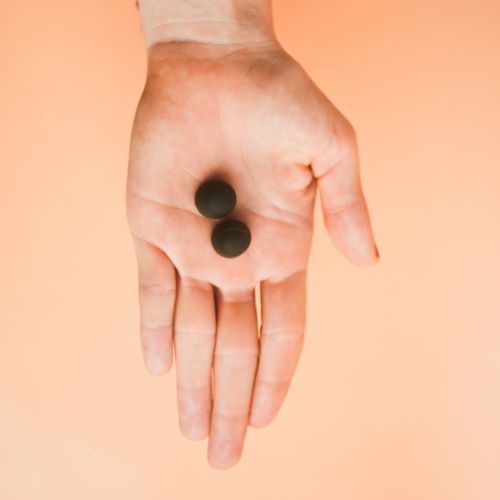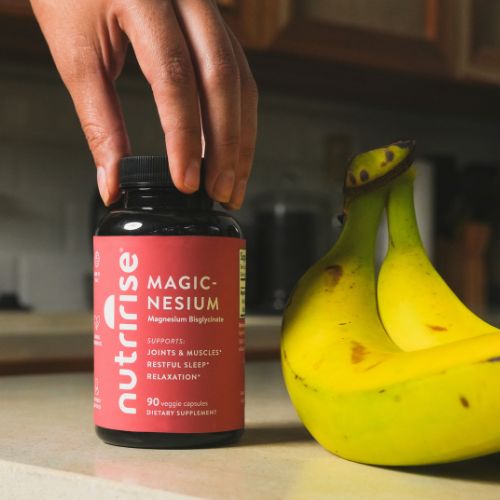What is insulin?
Insulin is a hormone produced by the pancreas that regulates blood sugar levels [1]. As long as the pancreas is functioning normally, hormone production never stops, so your body maintains basal insulin levels even during fasting.
On the other hand, increased secretion of this hormone occurs most often after a meal when there are an elevated amount of glucose and/or amino acids (AA) in your bloodstream.
AAs come from the breakdown of proteins (protein) in your diet. Some AAs are called glycogenic because they can be metabolized to glucose and also raise insulin.
In fact, the primary role of insulin is to help your organs and tissues absorb and store nutrients, and controlling your blood sugar is only a consequence of this process.
Beta cells in the pancreas, the body's primary insulin producer, are sensitive to blood sugar levels. Therefore, insulin secretion is stimulated by high glucose levels and suppressed by low levels.
Thanks to this hormone, glucose is stored as glycogen in the muscles and liver, and when these limited depots are filled, the excess is directed to fat cells and converted to fat.
Insulin also blocks the breakdown of fat and protein and prompts your muscles to take up more amino acids, which are the building blocks for hypertrophy.
Is insulin to blame for the obesity epidemic?
In general terms, we can say that insulin is the primary anabolic hormone in the body as it stimulates the synthesis and storage of all 3 macronutrients.
It is because of the anabolic nature of insulin concerning fatty tissue that it is often blamed as the main culprit for weight gain.
There are even beliefs and recommendations that keeping your insulin levels low can prevent you from gaining weight.
Alas, the truth is different - whether or not you gain fat depends on your overall calorie balance.
Even without insulin, if you overeat fat, you will store the excess in your fat depots [2].
Actually, the factor responsible for this process is not just insulin, but a much lesser-known hormone called acylation-stimulating protein (ASP), which is also involved.
ASP is activated when you eat more fat and push the excess directly to the depots. But if you are in a calorie deficit, you will lose despite the release of insulin after each meal.
Thus, it depends on your calorie intake and lifestyle whether insulin will replenish glycogen stores in your muscles and liver or increase fat stores.
What is insulin resistance?
Insulin sensitivity and insulin resistance are two reciprocal concepts that interact at all times: lower sensitivity equals higher resistance and vice versa.
Insulin resistance is when your cells respond less to insulin stimuli. IR happens because the sensitivity of their insulin receptors has decreased.
Almost all cells in your body have insulin receptors and therefore need insulin to absorb blood sugar as an energy source.
However, blood sugar in healthy people is absorbed to the greatest extent by skeletal muscle cells (about 80%), liver, and adipose tissue.
The cells of your brain also need glucose for energy but can absorb it without the help of insulin. On the other hand, the heart mainly uses fatty acids for energy and does not contribute significantly to overall insulin sensitivity.
Therefore, the sensitivity of skeletal muscle insulin receptors is considered a significant factor influencing overall insulin sensitivity.
When you have insulin resistance, the pancreas increases insulin production as a compensatory mechanism to reduce blood sugar levels to normal.
The body tries to compensate because high blood sugar levels can be dangerous. As insulin resistance progresses, your pancreas finds it harder and harder to compensate for the resistance with more and more insulin, leading to diabetes.
The most common complications of insulin resistance
Elevated insulin levels in insulin resistance are not harmless. They usually go hand in hand with a host of other health problems, which is why the condition is called "pre-diabetes" or "insulin resistance syndrome" [3].
Health problems occurring as part of insulin resistance syndrome include obesity, high blood pressure, poor lipid profile, low testosterone (in men), increased risk of heart disease, risk of stroke, and type 2 diabetes.
It is also known as metabolic syndrome or syndrome X. Statistics show that it is prevalent in the population of developed countries, and over 20% of people in the US have this syndrome [4].
While your body still manages the insulin resistance, the condition is called pre-diabetes.
Unfortunately, insulin resistance often worsens over time, and the pancreas may reach its maximum capacity for insulin production, which means it is no longer sufficient to manage the insulin resistance.
The condition then progresses to type 2 diabetes. Unfortunately, evidence suggests that over 50% of people with insulin resistance eventually progress to diabetes [5].
But even then, you shouldn't despair. In fact, a growing body of evidence shows that even with type 2 diabetes, the condition is reversible, and the most severe complications can be avoided if you take timely action.
What causes insulin resistance?
Genetics
Undoubtedly, multiple hereditary and genetic factors play a role in the development of insulin resistance [6]. Studies have conclusively shown that type 2 diabetes has a strong hereditary component, even more significant than type 1 diabetes [7].
However, genetics alone cannot explain the global epidemic of insulin resistance and type 2 diabetes. This is because your lifestyle, not genetics, has the final say.
Overeating
Studies have shown that fat accumulation, even within the normal body weight range, can lead to the development of insulin resistance [8].
For example, one study on the topic showed that if you overeat for just one month and gain about 3 kg, it can reduce your insulin sensitivity by over 10% [9].
Cases of insulin resistance in people of normal body weight are rare (most often because of very low muscular mass).
At the same time, researchers have revealed that obese men are about 32 times more likely to have insulin resistance syndrome than normal-weight men [10].
Research on the topic has also linked aging to reduced insulin sensitivity, which is most often directly related to low physical activity in old age and the typical loss of muscle mass and fat accumulation [11].
However, obesity can lead to insulin resistance syndrome even in children in about 1/3rd of cases [12].
Visceral obesity
Overeating and reduced physical activity can lead to a caloric surplus that underlies the obesity process. Visceral obesity is particularly dangerous as it affects insulin sensitivity and increases the risk of metabolic syndrome and type 2 diabetes [13].
This is what we call fat that accumulates around the waist and internal organs. Studies have shown that too much belly fat also increases the risk of heart disease and Alzheimer's disease [14].
For optimal health, your waist circumference should be less than 94 cm for men and less than 80 cm for women.
The risk of cardiovascular disease and diabetes is exceptionally high if your waist circumference is more than 102 cm for men and 88 cm for women.
Abdominal fat constantly releases free fatty acids (triglycerides) into the blood, reaching your muscles through the bloodstream and reducing their sensitivity to insulin.
Many studies have shown that a high amount of free fatty acids in the blood is associated with insulin resistance [15].
Currently, this is one of the leading theories for the occurrence of insulin resistance, but we need more studies to confirm it.
Low physical activity
A sedentary lifestyle also reduces insulin sensitivity [16]. Without regular physical activity, fat cells become relatively more sensitive to insulin than muscle cells, which further facilitates fat accumulation.
In combination with insulin resistance, this creates a vicious cycle: more fat → higher resistance → more fat...
In addition, low physical activity can also lead to muscle loss.
On the other hand, physical activity is a significant stimulus to your insulin sensitivity as it stimulates glucose uptake by skeletal muscle. Intense physical activity is the most effective way to reduce your BP immediately.
Fructose and hydrogenated oils (trans fats)
In addition to overeating and obesity, it is also thought that certain nutrients can increase the amount of free fatty acids in the blood, which further contributes to insulin resistance.
Such are fructose and trans fatty acids. The metabolism of fructose can only take place in the liver. The liver's glycogen stores can be rapidly replenished, and excess fructose leads to increased triglyceride synthesis [17].
If high fructose consumption is combined with visceral obesity, it also increases cardiovascular disease risk [18]. Industrial oils, such as artificially hydrogenated oils (trans fats), have also been associated with insulin resistance [19].
Furthermore, they should be avoided due to their negative effects on blood cholesterol levels, which accelerates atherosclerosis and increases the risk of heart disease and stroke [20].
How can supplements help?

Several supplements have been proposed to help improve insulin sensitivity, but the two that truly stand out from the rest are Garcinia Cambogia and chromium.
Experiments clearly show that the main active component in Garcinia Cambogia, called Hydroxycitric acid (HCA), has positive effects on insulin sensitivity [21]. The model showed reduced food intake, lower body weight gain, and attenuated inflammation, oxidative stress, and insulin resistance.
Clinical studies reveal that chromium is a potent micronutrient that can significantly increase insulin sensitivity. For example, a randomized controlled trial examined the efficacy of a chromium supplement on biomarkers of insulin resistance as well as BMI [22].
For the study duration of 6 months, researchers found that supplementation with 1000 μg of chromium picolinate improved insulin resistance, as seen by significantly reduced levels of fasting insulin and a significant reduction in body weight.
Another randomized controlled trial examined the efficacy of chromium supplementation on glycemic control in patients with type 2 diabetes [23]. The group taking chromium saw significant improvements in insulin sensitivity compared to the placebo group.
Furthermore, scientific evidence clearly shows that chromium can successfully prevent carbohydrate cravings and help patients with their fat-loss efforts [24].
Unfortunately, when choosing a Garcinia cambogia supplement, most options have low hydroxycitric acid content and rarely contain chromium as an addition.
Thankfully, Nutririse Craving Control combines optimal amounts of Garcinia Cambogia and chromium for maximum control. Moreover, it contains a whopping 95% HCA, which is amongst the highest concentrations available on the market.
And you can be 100% certain that the contents on the label match the contents of your supplement, thanks to the 4-stage quality control, which includes independent 3rd party testing.
The product ensures optimal and safe dosage by delivering 2100 mg a day. Taking your daily serving 20-30 mins before a meal with a full glass of water is best.
The appetite suppressant effects of Garcinia are further enriched by 420 mg of chromium in every dose. That is an essential mineral that regulates glucose metabolism and insulin sensitivity.
Note: This article is for informational purposes only, and not intended for use as medical advice. Always consult your healthcare provider before starting any dietary supplement.


































